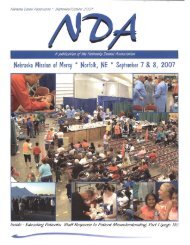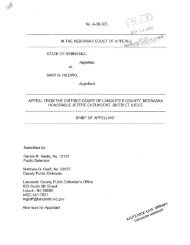Financial Articulation of a Fiduciary Duty to Bondholders with ...
Financial Articulation of a Fiduciary Duty to Bondholders with ...
Financial Articulation of a Fiduciary Duty to Bondholders with ...
Create successful ePaper yourself
Turn your PDF publications into a flip-book with our unique Google optimized e-Paper software.
1986]<br />
FIDUCIARY DUTY TO BONDHOLDERS<br />
protect the corporation from a perceived threat <strong>to</strong> corporate policy<br />
and effectiveness.' ' 1 8 The combined corporation fully complies <strong>with</strong><br />
all contractual obligations under all bond protective contractual<br />
provisions. 119<br />
Some <strong>of</strong> the subsidiary's s<strong>to</strong>ckholders dissent from the cash-out<br />
merger agreement and perfect their appraisal rights. 120 These s<strong>to</strong>ckholders<br />
and some <strong>of</strong> the original bondholders are risk-neutral and<br />
risk-liking inves<strong>to</strong>rs' 2 ' (during the time span <strong>of</strong> these events) 122 who<br />
possess unique investment facts and beliefs. 123 Arbitrarily, the net financial<br />
effect before the date <strong>of</strong> appraisal is, ceteris paribus, that<br />
s<strong>to</strong>ckholders gain wealth 124 and original bondholders lose corresponding<br />
wealth 25 because <strong>of</strong> unanticipated wealth expropriations in<br />
which: (1) s<strong>to</strong>ckholders lose wealth and original bondholders gain<br />
corresponding wealth due <strong>to</strong> the merger per se, 126 and (2) s<strong>to</strong>ckholders<br />
gain wealth and original bondholders lose corresponding wealth<br />
2 7<br />
due <strong>to</strong> the cash-outs per se.'<br />
A dispute over these gains and losses arises from the Delaware<br />
appraisal proceedings. Assume, representation by the original bondholders<br />
(Contractual Credi<strong>to</strong>rs), the dissenting s<strong>to</strong>ckholders (Ap-<br />
118. Id. at 1076.<br />
119. See DEL. CODE ANN. tit. 8, § 259 (1974).<br />
120. See supra text accompanying note 99.<br />
121. This locally neutralizes a postulate <strong>of</strong> the intertemporal capital-asset-pricing<br />
model. See supra notes 56-57 and accompanying text.<br />
122. This emphasizes the problem that if rules <strong>of</strong> law were <strong>to</strong> distinguish between<br />
risk-averse and non-risk-averse inves<strong>to</strong>rs in favor <strong>of</strong> the latter, see Easterbrook & Fischel,<br />
Corporate Control Transactions, 91 YALE L.J. 698, 711-14 (1982), then a riskaverse<br />
inves<strong>to</strong>r - whose risk averseness is determined in court by testing that inves<strong>to</strong>r<br />
- can always allege, perhaps truthfully, that at a relevant past time the inves<strong>to</strong>r was<br />
risk-neutral or risk-liking. The fact <strong>of</strong> past inadequate risk diversification supports<br />
such an allegation even though the inves<strong>to</strong>r's true state <strong>of</strong> mind at that time is unknown.<br />
Furthermore, an inves<strong>to</strong>r might be inherently risk-averse, risk-neutral, and<br />
risk-liking because "[a] utility function need not be everywhere concave or everywhere<br />
convex." H. MARKOWITZ, supra note 52, at 218. E. FAMA & M. MILLER, supra note 9,<br />
at 203; Friedman & Savage, supra note 53.<br />
123. This locally neutralizes a postulate <strong>of</strong> the intertemporal capital-asset-pricing<br />
model. See supra note 58 and accompanying text.<br />
124. This mimics a synergistic merger <strong>with</strong> respect <strong>to</strong> s<strong>to</strong>ckholders. See Brudney<br />
& Chirelstein, Fair Shares in Corporate Mergers and Takeovers, 88 HARV. L. REV. 297,<br />
308-09, 313-25 (1974).<br />
125. See Farrell, supra note 45, at 113 (stating that "for every s<strong>to</strong>ck owner who<br />
benefits from a s<strong>to</strong>ck buyback, acquisition, or leveraged buyout, there is a luckless<br />
holder <strong>of</strong> debt"); Weberman, Redmail, FORBES 173, 173 (Oct. 7, 1985) (stating: "In a lot<br />
<strong>of</strong> these big takeovers the acquired s<strong>to</strong>ckholders make a killing, but holders <strong>of</strong> the existing<br />
bonds take a hosing.").<br />
126. See Galai & Masulis, supra note 27, at 66, 68. This mimics a "negative"-synergistic<br />
merger <strong>with</strong> respect <strong>to</strong> s<strong>to</strong>ckholders. See Lorne, A Reappraisal <strong>of</strong> Fair Shares in<br />
Controlled Mergers, 126 U. PA. L. REV. 956, 976 (1978).<br />
127. See Galai & Masulis, supra note 27, at 69.








